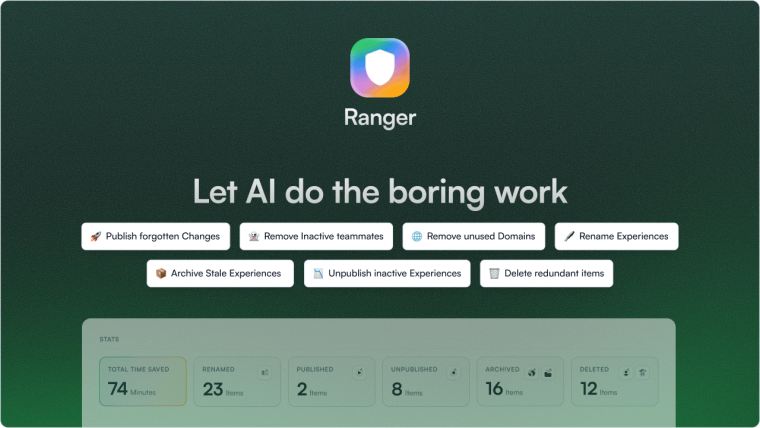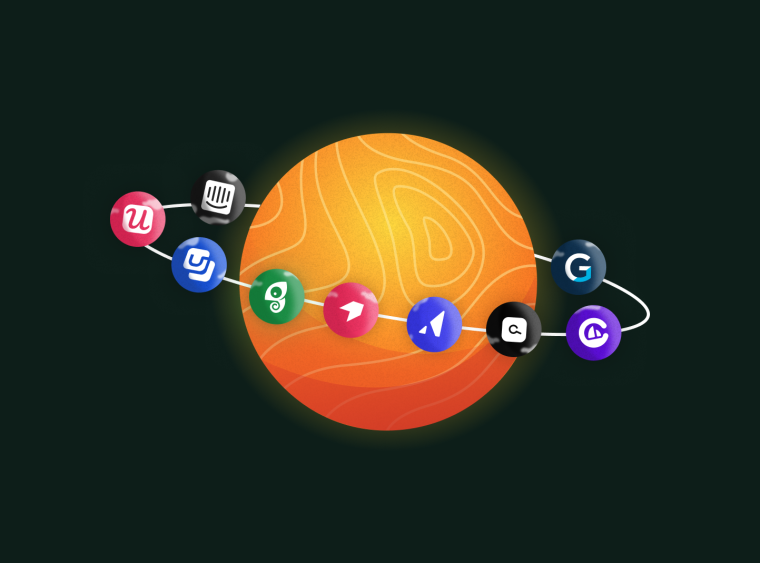You’ve spent months building the perfect product—only for your ‘ideal’ users to churn as soon as they sign up. What went wrong?
Achieving success with your product isn't just about creating a fantastic app. It's also about guiding users to realize the full value of your product to help meet their needs and get them to stick around. If you don’t have a clear product adoption strategy to nudge users toward their "aha!" moments, you’re leaving money on the table.
In this article, we provide a simple product adoption framework to create a solid plan. We also give you proven product adoption tactics to accelerate your user’s journey through the product adoption funnel to help you optimize the customer experience and facilitate customer success.
Read on to find out how to increase product adoption in eight simple steps.
What is a product adoption strategy?
A product adoption strategy is a structured approach to how businesses help users internalize and experience the value of a product so it becomes a part of their routine. It’s how you can ensure a fine-tuned approach to product adoption that’s replicated for all new users, increasing product and customer stickiness.
Understanding product adoption: stages and frameworks
Product adoption involves guiding users through the key stages of their customer lifecycle. From awareness and onboarding to engagement and value realization, it’s about highlighting your product’s value proposition and how it can positively impact your customer’s day-to-day.
The product adoption framework guides users to advocacy—the highest level of adoption—via a clear, five-step funnel:
Awareness: Users know of your product and how it might support their jobs to be done, but aren’t yet using it.
Trial: Users have decided to try your software—be it with a demo, free trial, or paid plan—to see whether it could support them in their roles.
Activation: Users encounter their first ‘aha!’ moment and begin to realize the value of your product.
Adoption: Users continue using your product after identifying how it can solve their problems and support them in their day-to-day.
Advocacy: Users are confident in your product’s ability to support their goals, and happily share their positive experience with other potential customers in their network.

Guiding users through this funnel turns first-time users into active users, and—eventually—into power users.
That being said, product adoption isn’t an end destination you can reach and call a day. Instead, your adopted strategy involves moving an ongoing loop of customers from a place of awareness to activation and adoption.
Setting clear goals for product adoption
To design a bulletproof product adoption strategy, you’ll need to define what product adoption looks like for your product, outline tactics to achieve this outcome, and identify the metrics you’ll use to measure your product adoption success.
Defining product adoption success should be a cross-functional activity—insights from Marketing, Customer Success, and Product are all hugely beneficial here. Everyone has their own tech and data stack that will prove exceptionally valuable for you when figuring out exactly what an engaged user looks like.
Then you’ll need to outline the tactics you’ll use to increase product adoption among users. This could include personalizing flows, using in-app guidance at key friction points, or even offering incentives for continued use—all of which we cover in the next section.
Finally, you need to identify the metrics you’ll use to track your progress. These metrics are how you’ll evaluate the success of your strategy—which helps identify whether it’s working, or whether you need to head back to the drawing board. Metrics include activation rate, user engagement score, time to value, and more.
How to increase product adoption: 8 steps to success
Increasing product adoption involves a lot of moving parts. You need to:
Identify user segments and needs
Simplify onboarding flows
Use in-app guidance
Monitor user behavior and collect feedback
Provide contextual support and documentation
Offer incentives for continued use
Regularly measure and optimize the product adoption funnel
Iterate and refine as your product evolves
Tending to all these parts helps create a consistent product adoption strategy. So, let’s look at each of these in depth. Here’s how you build a product adoption strategy that keeps users coming back for more.
1. Identify user segments and needs
First things first, know who you’re talking to. Different users have different needs, and will be enticed by different features and experiences. For example, a product manager needs different features from a project management tool than a UX researcher.
Identifying your user segments enables you to pinpoint and cater to the unique needs of your diverse user base. The best bit? Identifying your user segments isn’t all that tough.
For new customers, add a quick questionnaire to your sign-up flow to find out what their roles and jobs to be done are. For existing customers, consider sending out a quick survey to gather their details, or even deploy an in-app survey to get the info you need.
Collecting this data from users enables you to segment them. You can opt to do this by role, by seniority, by jobs to be done… the list goes on, and is entirely up to you. Consider your product and how best to segment users within it—it’s the foundation of a strong product adoption strategy.
2. Simplify onboarding flows
The user onboarding process sets the first impression for your product. A broken or cumbersome onboarding flow can instantly ruin that first impression and hinder product adoption.
The best onboarding flows typically contain personalized content catered to the user who’s being onboarded and their unique customer journey. This is made possible by the segments you created in step one, which help inform what features and capabilities to highlight for each user cohort.
Design your onboarding process to guide each user segment to their goals as quickly as possible. Here’s how:
Get a pulse of your users through feedback surveys and understand their expectations for the onboarding process
Create onboarding checklists and product walkthroughs to guide them through the interface and manage expectations, like this example from Grammarly

Create templates for new users to start with a reference point instead of a clean slate, like Trello prompts you to create your first board and shares some of its most popular templates to choose from. Thank you, Trello, you just made adopting your product into our daily workflows that much easier.

Strong onboarding sets users up for success, which is exactly what you want when considering product adoption.
3. Use in-app guidance
Use in-app messaging to spotlight critical features, offer more value, and increase product usage. Offer contextual self-serve support, like in-app widgets and guides, at different places in your product to remove barriers from activation.
At Chameleon, we call this kind of in-app messaging Launchers. Here’s an example of a Launcher in the form of a help menu that we recently created. This way, our new and long-term users can quickly launch a chat, read about feature updates, or even join one of our webinars:

Need a way to deliver precise, on-brand in-app guidance?
Chameleon’s suite of product adoption elements can be deployed across your interface to support users with in-app guidance when they need it most.
4. Monitor user behavior and collect feedback
Analyze user interactions within your app to collect data on user engagement and understand how user groups move through your product. Understanding how these cohorts interact with your product and its features enables you to deploy strategies and tactics to increase their engagement, such as well-placed in-app guidance or timely check-ins with Customer Success.
Here’s how you can analyze user behavior:
Divide your existing users into segments
Watch session recordings for users in each segment and identify trends
Collect user feedback using Microsurveys of feedback widgets
Compare qualitative and quantitative customer data
User behavior data and feedback will create many opportunities for upgrading the user experience. This could be anything from improving the user interface (UI) of your product to reduce friction, to adding new features to meet emerging user needs.
Whatever it is, you won’t know about it unless you ask. Keeping a close eye on users and their needs is crucial for strong product adoption rates.
5. Provide contextual support and documentation
Knowing which users trip up and where enables you to provide contextual support when your customers need it most. It gives you the opportunity to create feature onboarding, in-app messaging, and tours that help unblock users at key friction points during their journey.
For example, say your product and user research identifies that new users typically abandon the platform within a day if they don’t initially perform a key action: building their first dashboard. To push new users towards this action, you add contextual, in-app messaging to guide them towards the dashboard interface. You also add tooltips to onboard them to the feature, and link to comprehensive help documentation at previously-identified friction points.
Provide guidance where users need it most to encourage product adoption. After all, if users don’t know how your product can help them, they aren’t likely to stick around.
6. Offer incentives for continued use
Another great option for increasing product adoption is to offer incentives for continued use. This can be in the form of discounts, gifts, upgrades, merch, or any other extra perk that could encourage users to remain on the platform.
The idea is that the incentive encourages them to stick around long enough for you to wow them with your product. But keep in mind: even incentives won’t work if you lack strong product-market fit. After all, if your product doesn’t meet users' needs, why would they stick around?
Further along the product adoption line, you can also introduce referral incentives. This encourages users to share their experience with your platform with their network, hopefully attracting more new users.
7. Regularly measure and optimize the product adoption funnel
Ever heard the phrase ‘If you can’t measure it, you can’t manage it’? Tracking key product adoption metrics is essential for understanding whether your efforts are paying off (or whether you need to optimize your approach).
The key is to monitor metrics along the product adoption funnel—from awareness right through to advocacy. Some of these metrics include:
Adoption rate: This is the percentage of total customers using a feature within your product. This helps you look at which features show strong adoption, and don’t need as much of your time, and which ones show weaker adoption, meaning you might want to focus more resources on them.
Activation rate: This looks at the users that reach their activation event, which is defined by you and your team. This is an event that you know increases adoption for new users.
User engagement score: UES looks at how engaged your users are. Calculating UES involves identifying key adoption actions and assigning each a weighted score. You then multiply the weight of each action by the number of times it's performed to get your user engagement score.
Time to value: This measures the time between the first time the user interacts with your product and when they reach their aha! moment of value realization.
Usage frequency: This involves looking at daily average users as a percentage of total users for an idea of who’s engaging regularly. You can look at usage frequency from a daily, weekly, or monthly perspective.
Customer lifetime value: Calculating CLTV (or CLV) gives you a view of how your adoption has changed over time. CLTV likely won’t change overnight, but after continued efforts to increase adoption, you can expect CLTV to rise as more customers stick around.
8. Iterate and refine as your product evolves
Finally, it’s important to remember that your work is never done. Product adoption is an ongoing attempt to optimize the flows and features within your product to keep users happy and engaged.
User wants and needs can change quickly, meaning you need to continuously iterate and refine your approach based on new product and user data. To do this, make sure you keep your ear firmly to the ground and run continuous user research studies to keep your finger on the pulse of user expectations.
Whether it’s in-product surveys requesting feedback, one-on-one interviews with your most engaged users, or analyzing your product data for wins and losses, make sure you’re constantly asking yourself: “how can we make this better?”.
How to drive product adoption: Example of a product adoption framework in action
Now that you know what the product adoption funnel looks like and how you can optimize your approach to product adoption, let’s take a look at how these things work together. Imagine you’re looking at revving the product adoption revenue for a brand new project management platform: Managr.
Awareness
To stimulate awareness amongst your target audience, you create articles on how your PjM platform differs from others, demos showing your snazziest features, customer testimonials from power users, and any other marketing levers you have at your disposal.
You then share these in the spaces where your target users hang out, such as LinkedIn and Product Hunt, and with specific profiles.
Trial
Once new users have been convinced to give your project management tool a try, and are ascertaining whether it’s something they could gel with, it’s time to collect details from these new users to segment them efficiently. For your platform, you decide that segmenting by job function makes the most sense.
High-quality onboarding is crucial at this stage. To encourage adoption, you add in-product guidance and tooltips to support users' first steps within your platform.
Activation
Now that users are on your platform, you need to keep them there—and guide them towards activation.
To do that, you create different adoption flows for the segments you developed as users signed up. You show product managers the scheduling tools and the integration with Figma; finance professionals are guided towards the in-product calculator and invoice management capabilities; and HR is shown how to manage access and track individual profiles.
You then look into the results of your efforts by tracking feature adoption rates, time to value, and activation rates.
Adoption
By this stage, you’ve successfully attracted and activated new customers. Now, it’s time to make Managr a staple in their day-to-day lives.
To show users that you value their experience and are focused on optimizing it, you run user research studies into the core project management features. These are the most-used features across segments—from marketers to finance managers to designers.
You find that all segments would like more customization options for how they view their project management tasks. With this goal in mind, your UX and product team dig deeper into the issue and develop a solution that gives users the freedom to personalize every aspect of their task view. It’s tested every step of the way, so you’re unsurprised to find that post-launch usage and feedback are strong.
Alongside this feedback, you also track daily active users and usage frequency to see whether adoption picks up across the entire user base.
Advocacy
Now, onto the final step: advocacy. You’ve reached the point where your focus is on building strong customer relationships and encouraging happy users to share their thoughts on your product with their network.
You create a referral plan to motivate existing users to recruit new users. For every new user that signs on for a minimum of three months, the referee gets a $100 Amazon giftcard. Alternatively, they can opt to donate $100 to a charity of their choice.
You monitor referrals, new users, and customer acquisition costs to see the impact of your referral strategy, and see that new users are increasing and CAC (customer acquisition cost) is dropping. Managr is doing well.
This product adoption process is one that needs to be iterated continually—optimizing the process with every cycle. Failing to keep up with customer wants and needs is a recipe for disaster, and a surefire way to lose customers
How Chameleon can help drive new product adoption
Product teams spend months designing a product but often leave adoption as an afterthought. Don’t let this scenario happen to your team.
To drive product adoption at scale and deliver immediate value to users, you need a well-thought-out adoption strategy before the development process even begins. You need to know how you’ll attract, engage, and retain users, and how you’ll use the levers available to you to do so.
Chameleon helps you take full control over these levers of product adoption. With a comprehensive suite of in-product UX elements for engaging and guiding users, you’re able to drive product adoption from the get-go.
These include:
Product tours: targeted multi-step flows to guide users
Modals: front-and-center announcements to catch users’ attention
Tooltips: on-click or on-hover contextual help to unblock users at key moments
Checklists: to list key onboarding steps in your product
Microsurveys: for collecting targeted and contextual feedback
AI answers: summarized responses pulled from your help docs to support users in-app
With these tools at your fingertips, getting users invested in your platform and how it can help them is a whole lot easier.
Remember, keep the focus on your users and collect their input to shape your strategy. Double down on personalized UX, seamless onboarding, hassle-free support, and continuous iteration to maximize product adoption.







